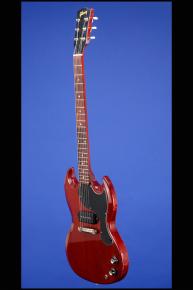One of the Last Wide-Neck SG Juniors
This featherweight guitar weighs in at just 5.50lbs. and has a nice, fat nut width of just under 1 11/16 inches and a standard Gibson scale length of 24 3/4 inches. Solid mahogany body with bevelled edge, one-piece mahogany neck, and rosewood fretboard with 22 original jumbo frets and inlaid pearl dot position markers. Headstock with gold silk-screened "Gibson" logo. Serial number "284348" impressed into the back of the headstock. Single-layer, black plastic, bell-shaped truss-rod cover with two screws. Closed-back double-line Kluson Deluxe strip tuners with white plastic oval buttons. One black plastic covered P-90 pickup with a super hot output of 8.53k. The pickup cover is stamped on the underside "UC-450-1 / 2". The pots are stamped "137 6504" (CTS January 1965). Three-layer (black, white. black) laminated plastic pickguard with eight screws. Two controls (one volume, one tone) on lower treble bout. Black plastic bell-shaped knobs with white markings. Jack socket on body face. Combination preset ridged "wrap-over" bar bridge/stud tailpiece. There are a few very small and insignificant surface marks on the edges. The body and neck are a deep rich cherry color with virtually no fading (there is a very minimal fade which is only visible when the pickguard is removed). There is virtually no wear to the original frets or the fretboard. There is some very fine body finish checking. This forty-seven year old lightweight "Screamer" is in exceptionally fine (9.00) condition. Housed in the original Gibson three-latch, shaped, black softshell case with brown felt lining (8.50).
This is one of the last of the SG Juniors with the preferred 1 11/16 nut width. In mid '65, Gibson in their infinite wisdom, cut the nut width down by a full 1/8 inch to 1 9/16 inches - and then in 1966 they changed the peg-head angle from 17 degrees to 14 degrees. Sometime in 1968 they re-introduced the 1 11/16 inch nut width and in 1973 they reversed the peg-head angle change back to 14 degrees…
"In 1958 Gibson made a radical design change to three of the Les Paul models, and a cosmetic alteration to another. The Junior, Junior 3/4 and TV were revamped with a completely new double-cutaway body shape. Ted McCarty explained the re-design as a reaction to player's requests. 'They wanted to be able to thumb the sixth string,' he said, 'but they couldn't do it if the only cutaway was over on the treble side. So we made them with another cutaway, so they could get up there. We did things that the players wanted, as much as anything.' The Junior's fresh look was enhanced with a new cherry red finish" (Tony Bacon, 50 Years of the Gibson Les Paul, pp. 33 and 36).
"Even in double-cutaway style, the Junior retained its charming simplicity. It is, if you like, the Fender Telecaster of the Gibson line: the guitar for the player who is fed up with all those over-complicated instruments out there and instead seeks heads-down no-nonsense boogie" (Tony Bacon, 50 Years of the Gibson Les Paul, p. 31).
"Considering all the Les Paul models as a whole, sales declined in 1960 after a peak in 1959. By 1961, Gibson had decided on a complete re-design of the line in an effort to try reactivate them...One of the first series of new models to benefit from Gibson's expanded production facilities was the revised Les Paul design, the SG ("Solid Guitar"). At first, these completely new instruments with their highly sculpted, double-cutaway design continued to be named Les Paul models, so guitars of this new style made between 1961 and 1963, with suitable markings are now known as SG/Les Pauls. But by 1963 the Les Paul name had been removed, and the models officially continued as SGs" (Tony Bacon, 50 Years of the Gibson Les Paul, p. 44).
Translate:











